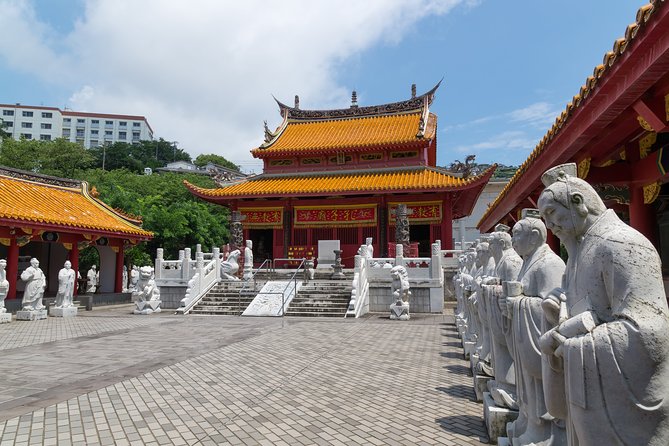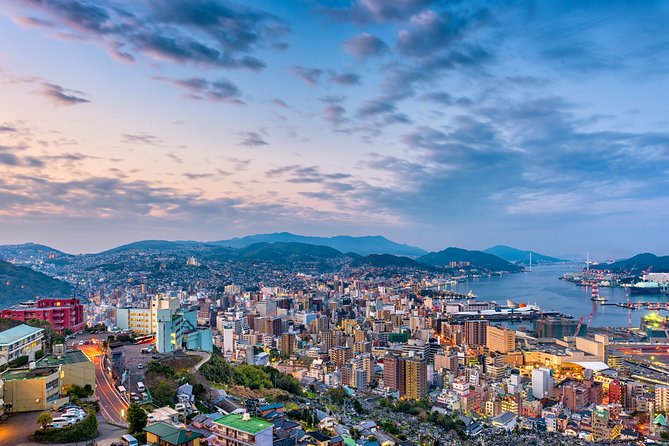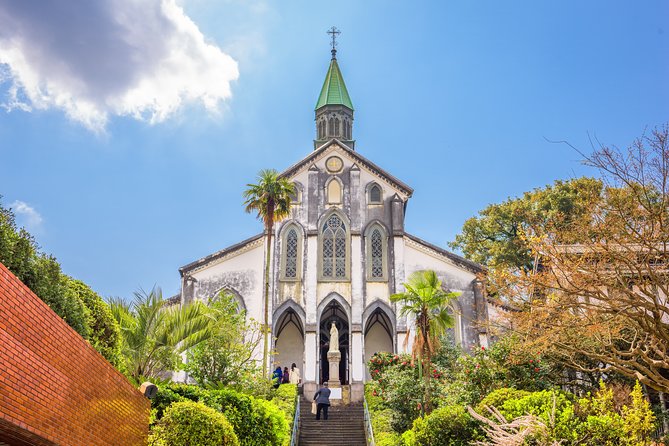Nagasaki’s rich heritage is on full display along the city’s captivating Heritage Trail. Visitors can’t miss the iconic Ōura Cathedral, its Neo-Baroque architecture a testament to the region’s diverse cultural influences. But the trail offers much more – from the engineering marvel of the Spectacle Bridge to the vibrant energy of Chinatown. For those eager to uncover Nagasaki’s remarkable history and traditions, this guided experience promises an unforgettable journey.
Good To Know

- Explore Nagasaki’s historic landmarks, including the iconic Ōura Cathedral, Glover Garden, and the Spectacle Bridge, on a private guided tour.
- Discover the architectural marvels and cultural significance of Nagasaki’s Chinatown, home to authentic Chinese cuisine and traditional handicrafts.
- Visit the Suwa Shrine, a 17th-century shrine honoring the deity Suwa, and learn about Nagasaki’s rich cultural heritage and spiritual practices.
- Reflect on the devastating impact of nuclear warfare at the Nagasaki Atomic Bomb Museum, which emphasizes the importance of nuclear disarmament and world peace.
- Conclude the tour with a peaceful visit to the Fukusaiji Temple, a Zen Buddhist temple dating back to the 16th century, surrounded by tranquil gardens.
Tour Overview

The Nagasaki Heritage Trail tour is a private guided experience that takes visitors on a journey through the historic and cultural landmarks of Nagasaki, Japan.
Priced from $224.22 per person, the tour provides access to Ōura Cathedral, public transportation, and a knowledgeable local guide. Participants will explore the city’s bridges, Chinatown, and other notable attractions.
Confirmation is received at the time of booking, and free cancellation is available up to 24 hours before the tour begins.
While the tour isn’t wheelchair accessible, most travelers can participate, as it’s located near public transportation.
You can also read our reviews of more historical tours in Nagasaki
Ōura Cathedral: A Lasting Legacy
Though it stands as a symbol of Nagasaki’s religious diversity, Ōura Cathedral‘s history is deeply intertwined with the city’s tumultuous past. Built in 1865, the cathedral is one of Japan’s oldest Christian churches.
It survived the 1945 atomic bombing, becoming a poignant reminder of resilience. Today, the cathedral’s striking Neo-Baroque architecture and intricate stained glass captivate visitors.
Climb the bell tower for panoramic city views. Inside, ornate altars and statues showcase the cathedral’s cultural and spiritual significance.
Ōura Cathedral remains a cherished landmark, preserving Nagasaki’s rich heritage and the enduring human spirit.
Glover Garden: Architectural Marvels

Perched atop a verdant hill, Glover Garden offers a captivating glimpse into Nagasaki’s architectural marvels.
Once the private estate of Scottish merchant Thomas Glover, the garden features a collection of stunningly preserved Western-style mansions. Visitors can admire the elegant Victorian-influenced design, complete with intricate wooden balconies and sweeping views of the city.
The centerpiece, Glover House, showcases Glover’s opulent lifestyle and his pivotal role in Nagasaki’s modernization.
Wandering the grounds, one can almost imagine the vibrant social gatherings that once took place, blending Japanese and European cultures.
Glover Garden stands as a testament to Nagasaki’s rich heritage and its enduring architectural gems.
Spectacle Bridge: Iconic Crossing
As one crosses the iconic Spectacle Bridge, they are immediately captivated by its graceful curves and striking silhouette against the Nagasaki skyline. This historic bridge, dating back to 1634, is a beloved landmark that has witnessed the city’s evolution. Its unique double-arched design, which earned it the nickname "Spectacle Bridge," is a testament to the engineering prowess of its creators.
| Feature | Description |
|---|---|
| Structure | Double-arched design with stone construction |
| Length | Approximately 202 meters (663 feet) |
| History | Completed in 1634 under the Shogunate’s order |
| Significance | Iconic symbol of Nagasaki’s rich heritage |
| Views | Stunning vistas of the city and harbor |
The Spectacle Bridge not only serves as a functional crossing but also offers breathtaking views of Nagasaki’s picturesque harbor and cityscape, making it a must-visit destination for any traveler exploring the city’s rich history and cultural heritage.
Chinatown Exploration
Stepping away from the iconic Spectacle Bridge, the tour now leads visitors into the vibrant heart of Nagasaki’s Chinatown.
Meandering through the bustling streets, the guide points out the unique architecture, temples, and lively markets that define this historic district.
Visitors can:
- Sample authentic Chinese cuisine at a local eatery
- Browse the colorful stalls selling traditional handicrafts and souvenirs
- Admire the intricate carvings and ornate decorations adorning the temples
- Learn about the district’s rich history as a center of trade and cultural exchange
- Immerse themselves in the lively atmosphere pulsing through this iconic neighborhood.
Suwa Shrine: Cultural Significance
From the lively Chinatown, the tour continues to the serene Suwa Shrine, a site of profound cultural significance in Nagasaki.
Established in the 17th century, this Shinto shrine honors the deity Suwa, a protector of fishermen and sailors. Visitors can admire the shrine’s intricate architecture, adorned with ornate carvings and vibrant red lacquer.
The peaceful atmosphere invites contemplation, while the surrounding gardens offer a tranquil respite from the bustling city.
As the guide shares the shrine’s history and traditions, travelers gain insights into Nagasaki’s rich cultural heritage and the enduring spiritual practices that shape the local community.
Nagasaki Atomic Bomb Museum: A Solemn Reflection
After exploring the rich cultural heritage of Nagasaki at the Suwa Shrine, the tour now transitions to a solemn reflection at the Nagasaki Atomic Bomb Museum.
This museum stands as a poignant reminder of the devastating impact of nuclear warfare. Visitors are guided through exhibits that:
- Recount the harrowing events of August 9, 1945
- Showcase personal belongings and stories of the victims
- Highlight the long-term effects on the city and its people
- Emphasize the importance of nuclear disarmament and world peace
- Inspire reflection on the human cost of conflict
The museum serves as a powerful educational experience, prompting visitors to contemplate the profound lessons of the past.
Fukusaiji Temple: Tranquil The Sum Up
As the tour makes its way through the historic streets, the group arrives at the tranquil Fukusaiji Temple.
This zen Buddhist temple dates back to the 16th century and offers a peaceful respite from the bustling city. Visitors can admire the ornate architecture, including the main hall and serene gardens.
The guide explains the temple’s significance and invites the group to explore the grounds at their own pace.
With the tour drawing to a close, the Fukusaiji Temple provides a calming conclusion to the Nagasaki Heritage Trail, leaving participants with a deeper appreciation for the city’s rich cultural tapestry.
Frequently Asked Questions
What Is the Best Time of Year to Visit Nagasaki?
The best time to visit Nagasaki is during the spring or fall. Spring offers mild weather and vibrant cherry blossoms, while fall brings cooler temperatures and stunning autumn foliage. Both seasons provide ideal conditions for exploring the city’s historic landmarks and cultural attractions.
Can Participants Take Photographs During the Tour?
Participants are generally allowed to take photographs during the tour, as long as they do not interfere with the group or disrupt the guide’s explanations. Some sites may have restrictions, so it’s best to check with the guide before taking photos.
Are There Any Dietary Restrictions or Special Needs Accommodations?
The tour does not mention any dietary restrictions or special needs accommodations. Travelers should contact the tour provider directly to inquire about any specific requirements or to discuss accessibility needs prior to booking.
How Long Is the Walking Distance Throughout the Tour?
The tour involves walking approximately 3-4 miles over the course of the day, with breaks and public transportation used as needed. Guests should wear comfortable walking shoes and be prepared for some uphill stretches.
Is There an Option to Extend or Customize the Tour Itinerary?
Yes, the tour can be customized or extended. Travelers can discuss their preferences with the tour provider to create a personalized itinerary that meets their interests and needs within the Nagasaki Heritage Trail experience.
The Sum Up
The Nagasaki Heritage Trail offers a captivating exploration of the city’s historical and cultural treasures. From the grand Ōura Cathedral to the iconic Spectacle Bridge, visitors are immersed in Nagasaki’s architectural wonders. The vibrant Chinatown and revered Suwa Shrine further showcase the city’s diverse heritage. This guided experience provides a profound understanding of Nagasaki’s past, inviting travelers to reflect on its resilience and rich tapestry of traditions.
More Historical Tours in Nagasaki
- Hasami Ware 2-Day Tour With Special Guide ~ 400 Years History and Modern Daily Use Pottery ~
- Experience Hasami Ware With Professionals ~ 400 Years History and Modern Daily Use Pottery ~
- Romantic Nagasaki: Historical Charms and Seaside Views
- Hasami Ware Study Tour With Special Guide ~ 400 Years History and Modern Daily Use Pottery ~
- Nagasaki Private Cultural and Historical Tour With Licensed Guide
- Nagasaki Heritage Trail: Cathedrals, Bridges & Chinatown
More Tour Reviews in Nagasaki
- Huis Ten Bosch Ticket in Nagasaki Japan
- Hasami Ware 2-Day Tour With Special Guide ~ 400 Years History and Modern Daily Use Pottery ~
- Nagasakis Hidden Gems: Private & Personalized Walking Experience
- Sasebo Private Customizable Full Day Tour
- Private Transfer From Sasebo Cruise Port to Fukuoka City Hotels
- Sunset Beach Dinner
Not for you? Here's more nearby things to do in Nagasaki we have reviewed
- Huis Ten Bosch Ticket in Nagasaki Japan
- Hasami Ware 2-Day Tour With Special Guide ~ 400 Years History and Modern Daily Use Pottery ~
- Nagasakis Hidden Gems: Private & Personalized Walking Experience
- Sasebo Private Customizable Full Day Tour
- Private Transfer From Sasebo Cruise Port to Fukuoka City Hotels
- Sunset Beach Dinner
- Make Lunch With Onsen Kitchen in Unzen
- Nagasaki Airport (NGS) to Nagasaki – Round-Trip Private Transfer
- Sea Kayaking and Beach Clean up in Ojika Island Nagasaki
- Nagasaki Heritage Trail: Cathedrals, Bridges & Chinatown
- Mochitsuki Rice Cake Making Experience in Ojika Island
- Nagasaki Airport (NGS) to Nagasaki – Arrival Private Transfer
